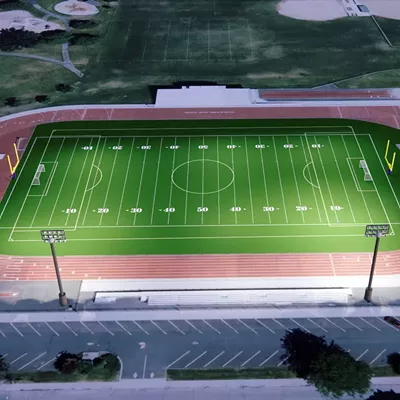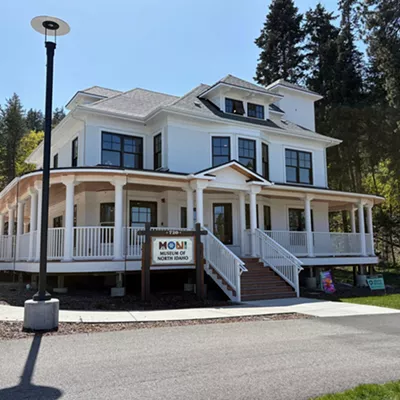"We should at least get the electeds from both sides to talk about policy," said Hession, "and about how we can provide maximum use of that water and the best way to protect it. And we should do it soon, maybe in Post Falls or Coeur d'Alene."
In the spirit of the moment, Post Falls Mayor Clay Larkin extended an invitation and offered to host the meeting.
"I'd like to do this in June," said Larkin in an interview this week. "The further away we get from the subject, the less impact the discussion will have." Larkin adds that the city of Spokane appears to be interested in a late summer/early fall gathering, while the city of Coeur d'Alene hasn't yet signaled its interest.
The logistics of convening a water summit may be difficult, when you consider the sheer number of people/agencies/interest groups that want to be at the table. For example, Spokane Tribal representatives say they expect to be invited. "We hope that they recognize the sovereignty of both tribes [Spokanes and Coeur d'Alenes]. We have senior water rights," says Spokane Tribal Council Secretary Gerald Nicodemus. "We look forward to a proactive discussion about how we can share water from the aquifer."
"Certainly people in Washington want to talk about how the aquifer recharges the river and about Spokane River flows," says Larkin. "And that also has a very dramatic impact for the people who live on the river and the lake [Coeur d'Alene]. So I'd expect that lakeshore owners would want to weigh in, too -- as would Avista."
Talks have already quietly begun at a higher level. Dave Tuthill, the new director of the Idaho Department of Water Resources (IDWR), met privately at the aquifer conference with Jay Manning, the director of Washington's Department of Ecology. "There is clearly a commitment between the directors to begin the process" of developing some kind of agreement about the use of water from the aquifer, says Ken Slattery, the program manager for Ecology's Water Resources Section in Olympia.
But there's no consensus yet about what such an agreement would look like.
"We could negotiate an interstate compact that would bind both sides for years," says Slattery. "That would take a long time to negotiate and it would have to be ratified by the legislatures in both states and by Congress. Idaho's not excited about that. Or we could try another approach," such as a less formal interstate agreement that would be easier to implement and change. If the two states can't make a deal, one (probably Washington) could force the issue and file a lawsuit, asking a judge or Congress to decide how the aquifer water would be divided.
"I can assure you that nobody in state government is talking about that as an option right now," says Slattery.
& lt;span class= "dropcap " & F & lt;/span & ormer Spokane County water manager Stan Miller remembers when Washington and Idaho had a financial incentive to work closely together to manage the aquifer.
"Tom Foley took an interest in aquifer protection in the late 1980s," remembers Miller. Foley used his influence to earmark $1 million for the region's aquifer protection work in 1988, with similar appropriations coming every year until Foley was voted out of office in 1994. "We made sure that, even though the check said 'Spokane County,' that half went to Idaho. We were bribing them," and the state of Idaho was happy to take the money. Miller believes, without the financial carrot, the relationship between Spokane and Kootenai County water officials isn't as strong as it once was.
Dick Martindale, the environmental health section manager at the Panhandle Health District, agrees with Miller's recollections. However, he says the relationship has been rejuvenated with a new bi-state Aquifer Protection Council whose members have made cross-border communication a high priority.
But there's no denying that the two states don't always see eye-to-eye. "The biggest difference between the two states," says Bob Haynes, the regional manager for the Idaho Department of Water Resources (IDWR), "is that Idaho has no place where the aquifer recharges the Spokane River. That all happens on the Washington side of the border."
"The state of Idaho will never see the level of the aquifer drop," says Miller. "If too much water is drawn from underground, it shows up in the river."
So when Washingtonians complain about low Spokane River flows (especially during the heat of summer), they're not likely to get a sympathetic ear from Idahoans.
"We recognize that will make things complicated," concedes Haynes. "We know that is something that has to be woven into any agreement."
& lt;span class= "dropcap " & T & lt;/span & his year, the state of Idaho will begin a process many think is long overdue: taking inventory of water rights and claims in the Coeur d'Alene/Spokane River basin and determining how those rights are used today.
"Idaho is required by law to allow beneficial water uses," says Coeur d'Alene water law attorney Art Macomber. "The essential problem is that the state has no idea how many rights are out there and what dates are attached to those rights."
Last year, the legislature agreed to resolve the problem by giving a Twin Falls court the authority to investigate and then decide which rights are valid and which aren't. That same court has worked for nearly 20 years to resolve water rights in the Snake River watershed. The North Idaho Adjudication, as it's called, is scheduled to be finished by 2011 or 2012, after which the court will move on to water rights in the Clark Fork/Pend Oreille and Palouse River basins.
"The state will ask people who hold water rights to show and support their claims to be able to keep those rights," says Macomber. "Let's say you were granted the right in 1980 to drill a well and the state allowed you to pump up to one cubic foot of water per second, but you've only been using half of that. As a claimant, my right then is only half-a-cubic-foot per second."
Macomber says the adjudication process for most water rights holders will be reasonably simple. "They can take their forms, fill them out and send them in. If there's no objection to the claim, no problem," he says. Many businesses and some private citizens with more complicated situations will have to hire attorneys. Macomber has held several free public workshops on the water adjudication process this spring; he'll sponsor one more on Saturday (9-11 am at the Rathdrum Lions Club, 16114 N. Meyer Road).
There's some debate in Washington about whether the Evergreen State should follow Idaho's lead and do its own adjudication.
"I wish the two states would have moved forward together on adjudication," said Spokane City Councilmember Mary Verner at the May 9 aquifer conference. County Commissioner Todd Mielke agreed: "Washington should follow Idaho so that we can make future decisions on a watershed basis."
Mayor Dennis Hession's position at the conference was more restrained: "As aggressively as Idaho is moving forward, [its process] will still take several years. We need to work cooperatively, whether it means adjudication or not."
Washington Ecology Department officials say they're studying whether adjudication is needed. "We already have a database with all these paper rights," says Keith Stossel, the section manager of the agency's Water Resource Program in Spokane. Perhaps the time and expense of adjudication won't be worth it, say state officials.
Whether Washington moves forward or not, one thing is clear: Idaho's policy to continue assigning water rights from the aquifer rankles its neighbors, in part because Washington hasn't issued any new rights in Spokane County since 1989. And even though the new study says the aquifer is handling the current demand for water, given the growth on the Rathdrum Prairie, that could change quickly.
Todd Mielke says Idaho's position may force elected officials in Washington to be more aggressive in protecting their constituents' rights to aquifer water, even so far as taking Idaho to court. "We shouldn't have to have the federal government make a decision to regulate our water use, and I certainly don't want that," he says. "But don't back me into a corner so that that's my only option."
For the people involved in the aquifer study, it was an exhausting experience. Some, like Bob Haynes from IDWR, aren't ready yet to determine the next steps. "We'll probably take time to digest the information. We've focused so much on just getting it done," he says.
If and when an aquifer summit is convened, the discussions and/or negotiations are likely to take time, if for no other reason than the large number of interests involved.
"Yes, it will be complicated," confirms Post Falls Mayor Clay Larkin. "But we have precedent with the [years-long] process of relicensing Post Falls Dam."
They can also look back at the recently completed 18-month negotiations that led to a local agreement about how to reduce the amount of dissolved oxygen in the Spokane River.
"I think," says Grant Pfeifer, Ecology's Spokane regional director, "you'll see a lot of behind-the-scenes conversations this summer."
















